|
|
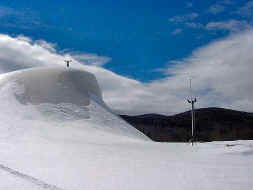 |
|
CVSD Snowfields |
Carrabassett Valley,
Maine, well known for some of the best skiing in the Northeast, has
placed itself on the map for another reason. Its wastewater authority has
successfully put in place the first permanent system of its kind in the
world to treat
and dispose of wastewater by spraying effluent into snow.
The
Carrabassett Valley Sanitary District serves approximately 900
living units plus the commercial facilities, the equivalent of about 6,000
people. The 7 lagoons are earthen-berm construction with clay lining.
The aerated lagoon and each of the initial three storage lagoons are
designed to hold 5.2 million gallons of sewage. Each backup lagoon is
designed to hold 5.8 million gallons, giving a total volume of
thirty-eight million gallons of which 33 million gallons is storage. The
treated effluent is then pumped to a land-based disposal system comprised
of a slow rate sprinkler irrigation system and freeze nucleation
(snowmaking).
|
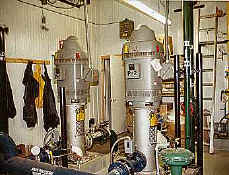 |
|
Two 125 horsepower vertical turbine
pumps (300 gpm each) deliver effluent to the snow making towers |
The
spray irrigation system is designed to empty the contents of the lagoons
plus the associated summer wastewater flow and precipitation. Effluent is
pumped to a forested disposal site, separate from the snowmaking site, at
fifty thousand gallons per acre per week.
Located in the western
mountains of Maine, Carrabassett Valley has historically relied on spray
irrigation for wastewater disposal of treated effluent during the summer.
As soon as the Carrabassett Valley Sanitary District (District) was
organized in 1993 to provide wastewater disposal services for the
Sugarloaf Mountain Ski Resort and surrounding area, the Board of Trustees
faced a shortage of lagoon storage space. Although their community is
small, it increases to more than 10,000 during ski season, and the lagoons
were full to nearly overflowing by the time the spray season began. Before
the concept of spraying effluent into snow was ever discussed, plans
called for construction of as many as 54 lagoons at a cost of $250,000
each and 26 spray irrigation areas, at a cost of $150,000 to $200,000
each, over 200 acres of wooded spray irrigation areas.
This construction would take place on the treatment site property, located
several miles from the access road to the Sugarloaf Mountain Ski Resort to
accommodate projected build-out of the sewered area.
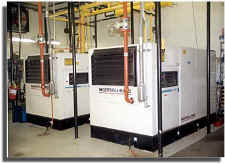 |
|
There are 2 two hundred
horsepower air compressors capable of delivering 800 cfm @ 140 psi. |
Never
entirely satisfied that the lagoon construction plan was the best
approach, sanitary district trustees went looking for an alternate
strategy. A less costly and more practical approach to wastewater
treatment and disposal by constructing snowmaking towers on the treatment
site property instead of scores of lagoons was the new direction taken. A
decade of environmental hurdles was about to begin in Carrabassett Valley.
The primary stumbling
block to be cleared was overcoming regulators' concerns about the fate of
contaminants, surface runoff, and over saturation of the soil.
Furthermore, without the Maine Department of Environmental Protection’s
blessing, financing sources were wary. Woodard & Curran, selected as the
newly organized Carrabassett Valley Sanitary District's engineer, analyzed
the technology. This analysis turned out to be the critical step in
allowing the project to move forward by explaining and resolving the issue
of contaminant fate and transport. An explanation to Maine DEP why it
worked by identifying the fundamental physical/chemical principles
involved took place. This convinced them that making snow was, in fact, a
viable treatment technology and cleared the way for license approval. The
project has moved ahead smoothly ever since.
|
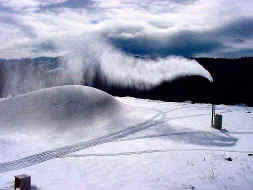 |
|
Snowmobile tracks cover the landscape. The
machines are used by the operators to keep a watchful eye on the
snowmaking process. |
Snow is made out of lagoon effluent throughout the winter and is spread
out over a cleared, prepared site. Melting and disposal into the ground
take place over the spring and early summer. This approach significantly
reduces the storage volume required by applying effluent to the fields
over the winter, when the influx of people to the ski resort results in
the District's highest flows. The process is intended as a disposal method
primarily, although the lagoon effluent receives additional treatment by
means of the freeze/thaw process.
Another
key to the process is making snow as soon as freezing weather starts. This
way the snow pack develops before the ground freezes. Then, in the spring,
when warm weather starts the melting process, the treated effluent (melted
water) infiltrates into the unfrozen ground with minimal runoff. It is not
uncommon to see mounds of snow still melting in July.
After
the systems first year of operation (28,000,000 gals. of effluent turned
into snow), the District Trustees voted to increase the operational
effectiveness by adding three additional snowmaking towers and a 750 kW
diesel generator. This reduced the power costs from $20,000 a month to
$18,000 annually (based upon costs of $0.50 /gal. of diesel fuel).
|
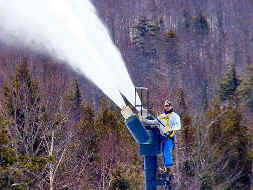 |
|
District Superintendent Dave Keith checks the nozzles atop the snow
gun tower |
The 1,000 horsepower generator powers 2 two hundred horsepower air
compressors capable of delivering 800 cfm @ 140 psi. Two 125 horsepower
vertical turbine pumps (300 gpm each) deliver effluent via buried 6-inch
welded steel pipe to the eleven 40-foot high snowmaking towers.
Normal snowmaking operations of 1,000 hours per year (42 days) are
required to turn the stored lagoon effluent into man-made snow. Facility
Superintendent David Keith describes optimum snowmaking conditions as
“cold and windy”.
This
two hundred and fifty thousand dollar ($250K) upgrade improved the ability
to more evenly distribute snow across the cleared application area and
reduced operating costs by approximately fifty thousand dollars ($50K)
annually with savings from in-house power generation and reduced site
maintenance. Design, equipment purchases, and planning were performed
in-house at a considerable savings.
|
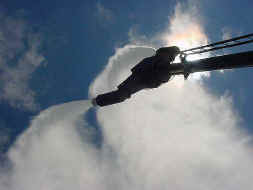 |
|
A
view from the bottom |
In
1997, CVSD recognized weaknesses in the snowmaking process control system.
The Trustees approved a further expenditure from the remaining balance of
construction funds to upgrade the snowmaking system from a PC based
control system to a PC/PLC based I/O system. The revised system is SCADA
technology that allows centrally based control, monitoring and reporting
(operator interface software) at the main control building. This allowed
communications locally to PLCs (processors and I/O with system programs)
within the control building and with the facility’s in-house power
generation system, at the snowmaking distribution vault and the District’
s sewage pumping station. To further enhance the system, both the District
Superintendent and Plant Operator have remote access and control of the
operating system via home-based personal computers.
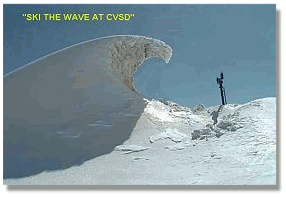
The
addition of snowmaking technology has the potential to more than double
the capacity of Carrabassett Valley's existing facilities without needing
any additional storage lagoons and within the existing 60 acres of land
application area. This effluent disposal project has relieved the
District's concerns for a long time to come.
|
Carrabassett Valley Sanitary District - Operational Snap Shot
In-House Three Phase Power Generation
|
| |
Gallons Processed |
Hours Operated |
Gallons
Hour |
Fuel Usage Gallons |
Fuel $$/Gal |
KWH Generated |
$$
KWH |
$$/Gallon Snowmaking |
|
Dec-99 |
3,234,562 |
100 |
32,546.6 |
3,994 |
0.50 |
53,230 |
0.0375 |
0.0006 |
| Jan-00 |
6,939,425 |
202 |
34,353.6 |
8,298 |
0.50 |
108,033 |
0.0384 |
0.0006 |
|
Feb-00 |
2,666,652 |
79 |
33,755.1 |
3,292 |
0.50 |
42,116 |
0.0391 |
0.0006 |
| Mar-00 |
581,246 |
15 |
38,749.7 |
579 |
0.50 |
8387 |
0.0345 |
0.0005 |
|
Dec-00 |
2,287,716 |
74 |
30,915.1 |
3,063 |
0.50 |
38,904 |
0.0394 |
0.0007 |
| Jan-01 |
5,036,128 |
146 |
34,494.0 |
5,986 |
1.17 |
75,392 |
0.0929 |
0.0014 |
|
Feb-01 |
3,026,193 |
87 |
34,783.8 |
3,489 |
1.25 |
45,469 |
0.0959 |
0.0014 |
| |
|
|
|
|
|
|
|
|
| Totals |
|
703 |
|
28,701 |
|
|
|
|
| |
|
Average |
34,199.57 |
|
|
0.0540 |
|
$0.00083 |
|
|
Lagoon Specifications

|
Lagoons |
No.1 |
No.2 |
No.3 |
No.4 |
Storage 1 |
Storage 1 |
Storage 1 |
|
Volume |
5.2 MG |
5.2 MG |
5.2 MG |
5.2 MG |
5.8 MG |
5.8 MG |
5.8 MG |
|
Aeration |
Coarse Bubble |
None |
None |
None |
None |
None |
None |
Comments:
Lagoons operate at 9.0 feet of depth.
Total lagoon area - 18 acres or 780,00 sq. ft.
System Information

|
Design Flow |
Licensed to
Discharge 40 MG/Year
to Spray Irrigation and 56 MG/Year |
|
Actual Flow |
0.10 to 0.40 MGD
(highest in winter) |
|
Discharge To |
Land Application |
|
Year Built |
1985 |
|
Design Engineers |
James Sewall Co.
Upgrade - Woodard and Curran |
|
Septage Received |
No |
|
Collector System |
12 miles gravity
sewer, 1 pump station , 280 manholes |
|
Staff Size |
2 Full Time |
|
Number of Users |
Year round 100
users. Winter peaks to 4,000 people |
|
Billing Software |
Uses GIS for
collection system maintenance |
|
|

